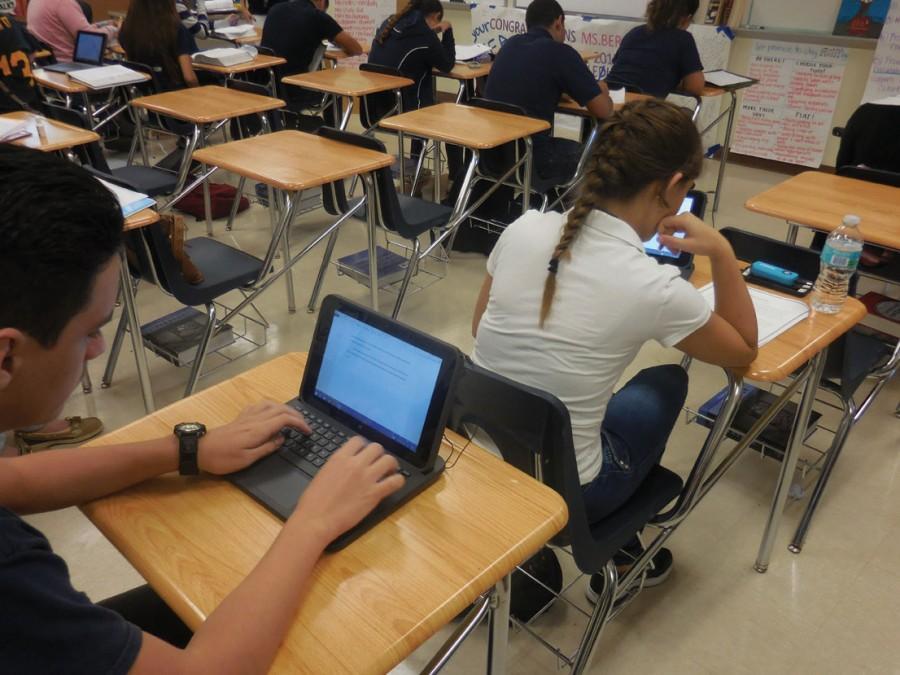Tablets for Tenth
Photo by John Clement
Sophomore William Sanpedro uses his tablet to work in Ms. Berrios’ class
Textbook?
Check.
Notes?
Got it.
Research?
One step ahead of you
As your friend is surrounded by stacks of paper and books, he can’t help but be astonished by how efficient you are with your new HP Pro 10 EE Tablet.
After their introduction last year, tablets have come back again to Miami High with an upgrade. The new HP Pro 10 EE Tablet is not only designed to make learning a breeze for tenth graders, but it is also faster, slimmer, and lighter than what tenth graders were issued last year.
Tablets are not available to all Miami High students, though. Sophomores obtained a tablet through their English class, while freshmen got theirs through their World History class. Getting a tablet, however, is not a requirement. You can opt out of getting a school tablet and bring your own device to school instead.
Many students were happy to receive the new technology. “I agreed to get one,” said sophomore Larsen Barrera. “From my experience, it really gives extra help in class.”
Sophomore Jostin Armada finds the tablets very convenient for lessening weight in his backpack. Because certain textbooks are preloaded onto the device, he doesn’t have to go through the hassle of carrying the heavy physical copies.
“Using the web is the best part of having it,” says sophomore Esauly Gomez. “It’s much easier answering questions by searching for the answers online rather than flipping through a whole book.”
In order to get your tablet, a fee must be paid first. The amount necessary is dependent on what you pay for lunch. If you pay full price for lunch, the fee is $20, those with reduced lunch pay $10, and those with free lunch pay $5. “Not a bad deal,” commented tenth grade English teacher Mr. Montesano.
In a public statement, MDCPS superintendent Alberto M. Carvalho, sees tablets, and technology as a whole, as useful tools that can bring out potential in schools. “When technology is used correctly, we have seen powerful results in our very own technology-rich iPrep Academies, for example, with better test scores and increased employment opportunities [for students],” he said.
Tablets can be used in many ways in the classroom. Because these devices have such a wide range of possible functions all packed into one unit, they are able to change the way students learn for the better.
“Reading and writing, that’s what they’ll be used for. That includes research,” said Mr. Montesano. “The main advantage will be that students will be able to make use of the digital textbook. In the 21st century, with ever-changing technology, the e-book is where we are going.”
Mathematics teacher Mr. Sabando said, “They’re not limited to one topic like books are. Enter in any question you have, and you’ll have an answer.” He plans on using the tablets with Kahoot, an educational website that allows students to participate in online quizzes.
New librarian Ms. Bravo, who has had experience using tablets in class during her time as a 9th grade reading coach, found them to be helpful because of their ability to research on the web as well as upload and share. Group work is also a possibility, she added, since sharing documents is made easy with cloud storage.
Tablets aren’t for everyone, though. Some people prefer using old fashioned methods of learning over their digital counterparts. “I signed up for a tablet, but books are my still my go-to option because they’re reliable,” says sophomore Felipe Flores. “They don’t run on energy like tablets so there’s no risk of being cut short from what I am doing.”
Mr. Sabando adds, “I prefer books – I’m old school. I’m more used to the unique feel of reading a book.”
Students are responsible for taking care of their school-issued tablets. “I encourage students and teachers alike to embrace these tablets,” said Mr. Montesano. “If they don’t, they might drop them – and that could be bad.”
Sophomore Eddy Santiesteban said it’s not very hard to do. As long he keeps his device safe in his backpack, there’s hardly a problem.



